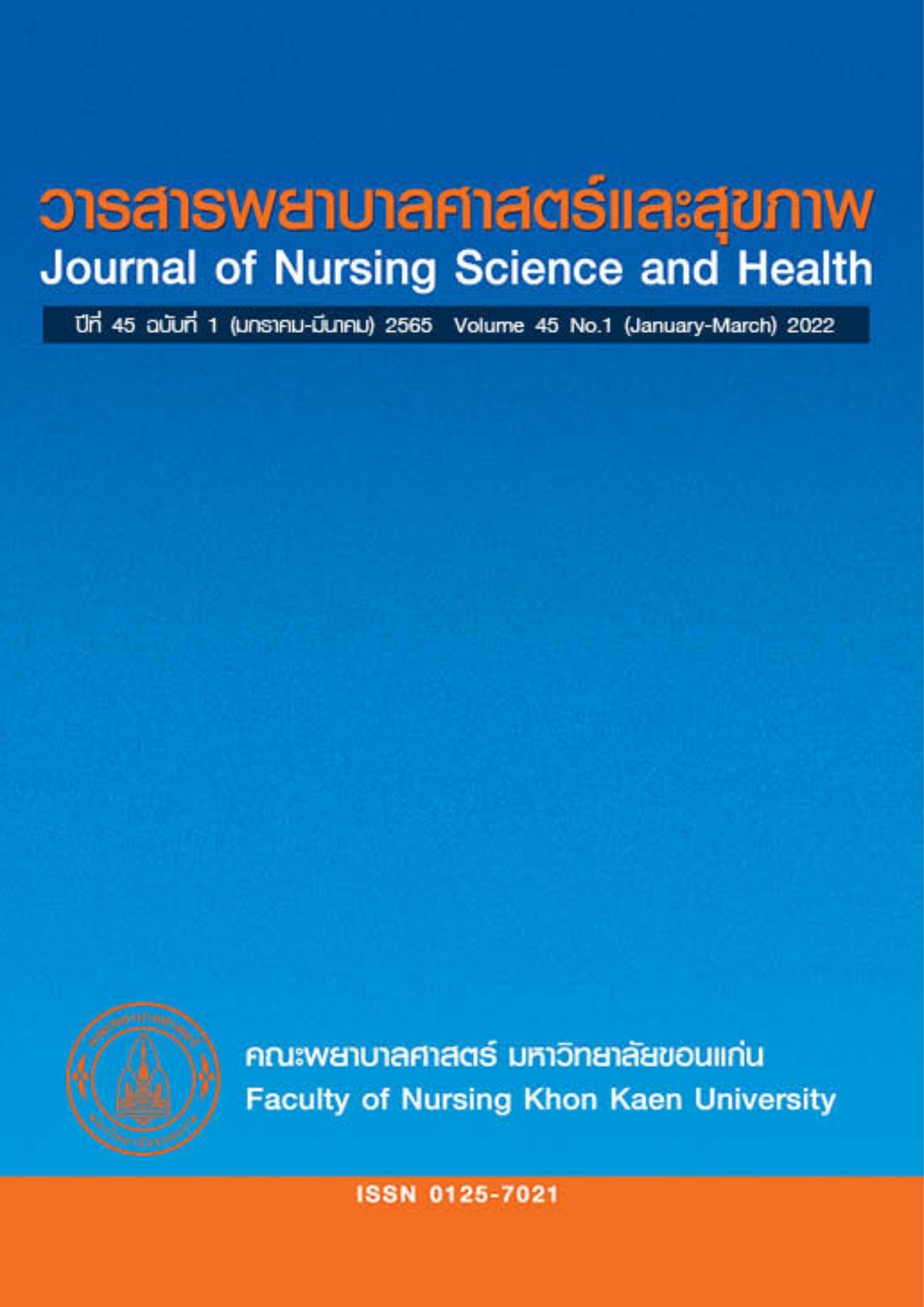ผลของการเดินจงกรมต่อการควบคุมความดันโลหิตในผู้ป่วยที่มีประวัติความดันโลหิตสูงวิกฤต
คำสำคัญ:
ความดันโลหิตสูงวิกฤต, เจริญสติ , เดินจงกรมบทคัดย่อ
ผู้ป่วยที่มีประวัติความดันโลหิตสูงวิกฤตที่ควบคุมความดันโลหิตไม่ได้ตามเป้าหมาย มีความเสี่ยงต่อการเกิดภาวะแทรกซ้อนที่รุนแรง และอาจเสียชีวิตได้ การศึกษานี้มีวัตถุประสงค์เพื่อศึกษาผลของการเดินจงกรมต่อการควบคุมความดันโลหิตในผู้ป่วยที่มีประวัติความดันโลหิตสูงวิกฤต โดยเป็นการวิจัยเชิงทดลองแบบสุ่มที่มีกลุ่มควบคุม ในโรงพยาบาลศรีนครินทร์ คณะแพทยศาสตร์ มหาวิทยาลัยขอนแก่น ระหว่างเดือนสิงหาคม 2563 ถึงเดือนมีนาคม 2564 กลุ่มตัวอย่างเป็นผู้ป่วยโรคความดันโลหิตสูง 64 คน แบ่งเป็นกลุ่มควบคุมและกลุ่มทดลอง กลุ่มละ 32 คน กลุ่มทดลองเดินจงกรม 20 นาที ทุกวัน จำนวน 30 วัน พระสงฆ์ผู้เชี่ยวชาญจากมหาวิทยาลัยจุฬาลงกรณ์ราชวิทยาลัยวิทยาเขตขอนแก่นเป็นผู้สอนเดินจงกรมจนผู้ป่วยสามารถทำได้อย่างถูกต้อง ทั้งสองกลุ่มได้รับการรักษาและการปรับเปลี่ยนพฤติกรรมตามมาตรฐาน และวัดความดันโลหิตและจดบันทึกที่บ้านทุกวัน เปรียบเทียบความดันโลหิตก่อนและหลังเดินจงกรมโดยใช้การทดสอบที (วันที่ 0 และ 30) ผลการศึกษาพบว่ากลุ่มทดลองมีความดันโลหิตช่วงหัวใจบีบตัวหลังเดินจงกรม (systolic blood pressure, SBP) ลดลงต่ำกว่ากลุ่มที่ไม่เดินจงกรมเฉลี่ย 5.80 มิลลิเมตรปรอทอย่างมีนัยสำคัญทางสถิติ (95% CI -1.82, -9.79, P <0.01) เช่นเดียวกันกับความดันโลหิตช่วงหัวใจคลายตัว (diastolic blood pressure, DBP) ของกลุ่มเดินจงกรมลดลงต่ำกว่ากลุ่มไม่เดินจงกรมเฉลี่ย 5.61 มิลลิเมตรปรอท (95% CI -1.31, -9.9, P <0.01) จากผลการศึกษาสามารถสรุปได้ว่าการเดินจงกรมมีประสิทธิผลและสามารถนำไปใช้เป็นการบำบัดเสริมกับการรักษาปกติในผู้ป่วยที่มีประวัติความดันโลหิตสูงวิกฤตเพื่อให้ควบคุมความดันโลหิตได้ดีขึ้น
เอกสารอ้างอิง
Phokaiwanichkul T. Hypertension Crises. In: Wattanasirichaikul S, Srilamard D, Prayongrat K. editors. Textbookofemergencymedicine. 3rd ed. Bangkok:FacultyofMedicine,Srinakharinwirot University; 2010. p. 39-59. (in Thai)
Thai Hypertension Society. Thai guidelines on the treatment of hypertension 2019. Bangkok: Thai HypertensionSociety; 2019. (in Thai)
Bureau of Non Communicable Disease. The statistic of non-communicable disease 2007-2015 [Internet]. 2016 [cited 2016 Jun 1]. Available from http://www.thaincd.com/information-statistic/non-communicabledisease-data.php (in Thai)
Statistic of hypertension patient in Srinagarind Hospital. Khon Kaen: Faculty of Medicine, Khon Kaen University; 2019. (in Thai)
Statistic of hypertensive crisis patient in hyprtensive crisis clinic, Srinagarind Hospital. Khon Kaen: Faculty of Medicine, Khon Kaen University; 2019. (in Thai)
Imoun S, Mitsungnerm T, Techa-atik P. Effectiveofaprayingtherapyforblood pressure control of hypertensive patients. J Nursing and Health Care 2015; 32(2):44-53. (in Thai)
Kotruchin P,ImounS,MitsungnernT,Aountrai P, Domthaisong M, Kario K. The effects of foot reflexology on blood pressure and heart rate: A randomized clinical trial in stage-2 hypertensive patients. J Clin Hypertens 2021; 23(3):680-6.
Imoun S, Kotruchin P, Techa-atik P, Mitsungnern T. The effectiveness of local folk musical therapy for blood pressure control. Journal of Nursing Science & Health 2018; 41(1): 12-23. (in Thai)
Chonsaringkart D. Acute effects of walking meditation on blood pressure level in Thai hypertensive patients. Bangkok: Faculty of Medicine, Chulalongkorn University; 2008. (in Thai)
Krutdilakanunt J. Effects of rosary count meditation practice on stress, heart rate, respiration rate and blood pressure of nursing students at thefirst experienceonhospital ward. J HealthSci 2015; 24:479-85. (in Thai)
Vareesangthip J. A study of the effects of the insight meditation practice on the levels of the blood pressure. J Graduate Studies Review 2015;11(2):32-44. (in Thai)
Prasawang N, Koshakri R, Jewpattanaku Y. Effect of the sitting breathing meditation combined with usual care on blood pressure among patients with essential hypertension in primary care unit. J Nurs Health Care 2018;36(1):33-42. (in Thai)
Panyachotikun A, Satkong S, Sriwisit S. Effect of SKT meditation therapy for lowering blood pressure level of patient swith hypertension in Sikao hospital, Trangprovince. TheSouthern College network J nursing and Health. 2017; 4(2):245-55. (in Thai)
Chibsamanboon P, Suttineam U. Effects of the STK 2 on blood pressure levels and chemical markers. J Boromarajonani College of Nursing, Bangkok 2013;29(2):122-33. (in Thai)
Hetthong J, Tongchouy B. Effectsofmeditation therapy program towards reducing blood pressure level among individuals with prehypertensive. J Health Science, Thaksin University 2019;1(1):43-9. (in Thai)
Kawinwonggowit V. Osteoarthitis. Electronic magazine @Rama 2015;2:4-5. (in Thai)
Jiraworapong C. Walking meditation: Goodfor healths. Buddhachinaraj Med J 2009; 26(3): 302–11. (in Thai)
Roy SC, Andrews HA. The Roy adaptation model. 2nd ed. Stamford, Conn: Appleton & Lange; 1999.
Whelton PK, Carey RM, Aronow WS, Casey DE, Collins KJ, Dennison Himmelfarb C, et al. 2017ACC/AHA/AAPA/ABC/ACPM/AGS/APhA/ASH/ASPC/NMA/PCNA Guideline for the prevention, detection, evaluation, and management of high blood pressure in adults: Executive summary: A report of the American College of Cardiology/American Heart Association task force on clinical practice guidelines. Hypertension 2018 Jun; 71(6):1269–324.
Teawasagonwong O. Result of buddhist meditation program on level of blood pressure and health behavior the hypertension patients of Langsuan hospital, Chumphonprovince [thesis]. Petchaburi: Petchaburi Rajabhat University; 2012. (in Thai)
Gainey A,Himathongkam T, Tanaka H, Suksom D. Effects of buddhist walking meditation on glycemic control and vascular function in patients with type 2 diabetes. Complement Ther Med 2016 Jun;26:92–7.
Bernard, R.Fundamentalsofbiostatistics 5th ed. Duxbery: Thomsonlearning; 2000.
Sangwatanaroj S. Nonepharmacological treatment of HT: What you never know. Bangkok: Department of Medicine, Chulalongkorn University; 2016. (in Thai)
ดาวน์โหลด
เผยแพร่แล้ว
รูปแบบการอ้างอิง
ฉบับ
ประเภทบทความ
สัญญาอนุญาต
ลิขสิทธิ์ (c) 2022 วารสารพยาบาลศาสตร์และสุขภาพ

อนุญาตภายใต้เงื่อนไข Creative Commons Attribution-NonCommercial-NoDerivatives 4.0 International License.
วารสารพยาบาลศาสตร์และสุขภาพเป็นเจ้าของลิขสิทธิ์ในการเผยแพร่ผลงานที่ตีพิมพ์ห้ามผู้ใดนำบทความที่ได้รับการตีพิมพ์ในวารสารพยาบาลศาสตร์และสุขภาพไปเผยแพร่ในลักษณะต่าง ๆ ดังนี้ การนำบทความไปเผยแพร่ออนไลน์ การถ่ายเอกสารบทความเพื่อกิจกรรมที่ไม่ใช่การเรียนการสอน การส่งบทความไปตีพิมพ์เผยแพร่ที่อื่น ยกเว้นเสียแต่ได้รับอนุญาตจากวารสารพยาบาลศาสตร์และสุขภาพ



